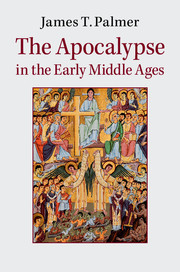Book contents
- Frontmatter
- Dedication
- Contents
- List of figures
- List of maps
- Acknowledgements
- List of abbreviations
- Maps
- Introduction
- 1 The end of civilisation (c. 380–c. 575)
- 2 The new urgency (c. 550–c. 604)
- 3 The ends of time and space (c. 600–c. 735)
- 4 Pseudo-Methodius and the problem of evil (c. 680–c. 800)
- 5 Charlemagne, pater Europae (c. 750–c. 820)
- 6 A Golden Age in danger (c. 820–c. 911)
- 7 The Year 1000 and other apocalypticisms (c. 911–c. 1033)
- Conclusion
- Select bibliography
- Index of manuscript references
- General index
- References
5 - Charlemagne, pater Europae (c. 750–c. 820)
Published online by Cambridge University Press: 05 November 2014
- Frontmatter
- Dedication
- Contents
- List of figures
- List of maps
- Acknowledgements
- List of abbreviations
- Maps
- Introduction
- 1 The end of civilisation (c. 380–c. 575)
- 2 The new urgency (c. 550–c. 604)
- 3 The ends of time and space (c. 600–c. 735)
- 4 Pseudo-Methodius and the problem of evil (c. 680–c. 800)
- 5 Charlemagne, pater Europae (c. 750–c. 820)
- 6 A Golden Age in danger (c. 820–c. 911)
- 7 The Year 1000 and other apocalypticisms (c. 911–c. 1033)
- Conclusion
- Select bibliography
- Index of manuscript references
- General index
- References
Summary
The world grew old. The Year 6000 approached. And yet the last decades of the eighth and the beginning of the ninth century have often been considered a Golden Age. The increased competition for power in the last days of the Merovingian kingdoms eventually gave rise to a new political order under the Pippinids (later Carolingians) which, even if prone to posturing and great acts of self-legitimisation, believed in the centrality of the sacred. More plainly than before – or at least for a while – political activity in the West was conducted with a consciousness of apocalyptic tradition as part of the mix of ideas which inspired, shaped and drove people onwards. This was possible in no small part because of the actions of Charlemagne (r. 768–814) – one of the most famous figures of early medieval history and ‘Father of Europe’ (pater Europae) in his own lifetime. He forged the widest sense of political and intellectual hegemony since the Roman Empire, engaging in conquest, mission, reform and cultural production. And on Christmas Day 800, as the world did not breathe its last in its 6,000th year, he was crowned emperor in Rome, recreating the empire that was to endure in the West until the discessio predicted by Paul and reinterpreted by Pseudo-Methodius.
Judging the power of the apocalyptic in Charlemagne’s empire is no easy task. The last sentence of the above paragraph describes a view of events that emerges only ex silentio. Richard Landes, one of the first historians to explore Carolingian apocalyptic, argued that the silence spoke volumes about the anti-apocalyptic majority, probably led by Charlemagne, who wished to avoid the uncomfortable non-Augustinian significance of the completion of 6,000 years and who successfully reached a quiet ‘consensus’ to say nothing. The silent anxiety, then, would be the defining dynamic at work. Few Carolingianists have been interested in following up Landes’s thesis, some uneasy at the ‘silence’, some left cold by a theme which seems peripheral to both their research and their sources. Wolfram Brandes once had an important study of Carolingian apocalypticism rejected for publication because an editor could not ‘believe that Charlemagne had anything whatsoever to do with eschatological thinking’. This is more than a little regrettable because there is a rich source-base which rather indicates that there were vigorous mainstream apocalypticisms.
- Type
- Chapter
- Information
- The Apocalypse in the Early Middle Ages , pp. 130 - 158Publisher: Cambridge University PressPrint publication year: 2014



